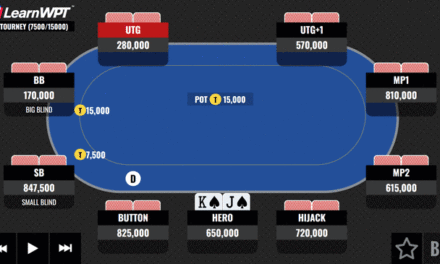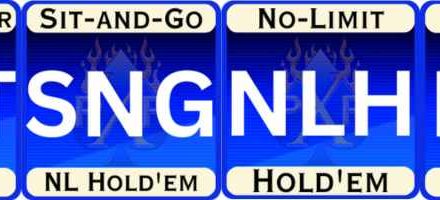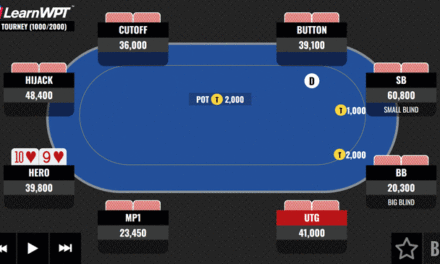
In our first two articles in this series (see Part 1 and Part 2), we primarily dealt with the theory behind exploitative adjustments. In this one, we’ll give a real-world example of how you might adjust to a player in real-time based on information seen at showdown.
Let’s say you’re sitting in a daily tournament, and you’re on the button a few orbits in. You see a hand get to showdown, and the player in middle position shows down Ace Five offsuit (A5o) as a hand they raised first-in with.
If we look at what a first-in range is supposed to look like at 50 BBs, it should be something like this:
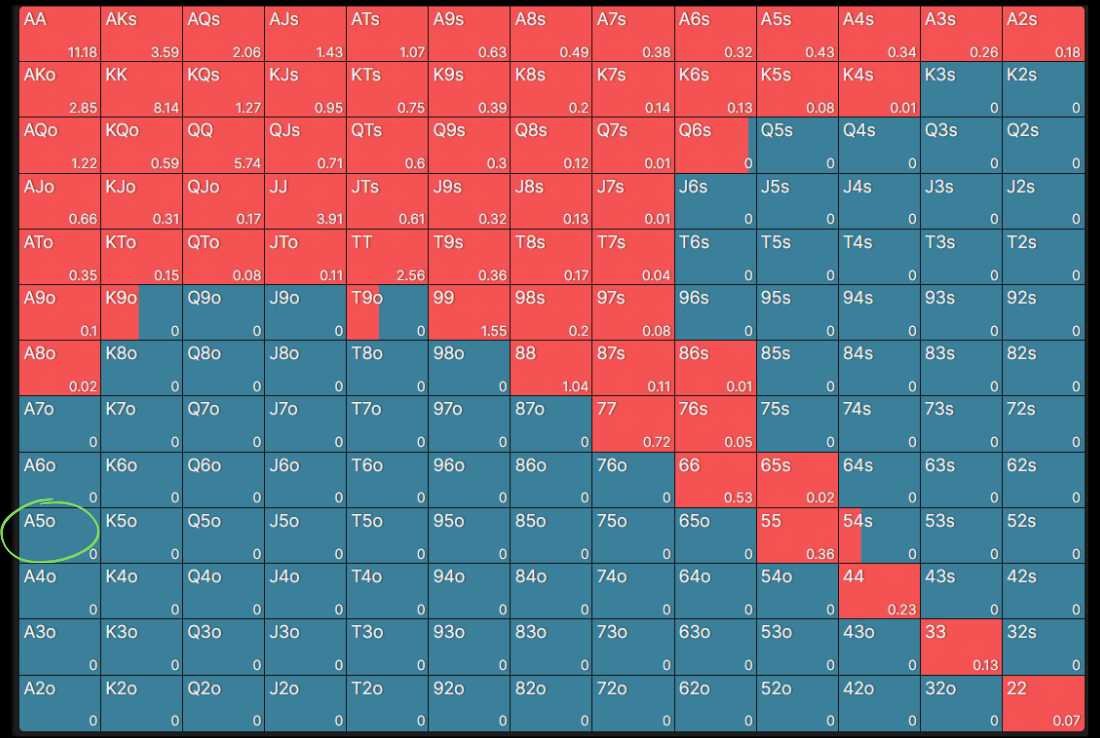
As you can see, A5o is not anywhere NEAR on that list!
Why we shouldn’t play too many hands
In our previous article, one of the things we discussed is the reason not to play more hands than we should have to do with equity realization. The main reasons are:
- We have to fold to 3-bets too often when our range gets too wide;
- Many hands (like A5o!) have difficulty realizing their equity out of position.
With a hand like A5o, most of the time when you connect you will flop top pair with a bad kicker or bottom pair with a good kicker. While you could flop two pair or better, it will be less than 5% of the time. This means that in most instances, you will either miss or have to attempt to navigate your way to a showdown with a vulnerable hand, most likely out of position.
So, what do we do to punish a player who opens too widely? (Of course, you will want to see more evidence of a player opening too wide – not just one hand – but let’s say we see a pattern of the player doing this.)
Typical Play vs. Unknown Opponent
Here is what a “typical button” response looks like against someone who opens in the middle position and it is folded to us:
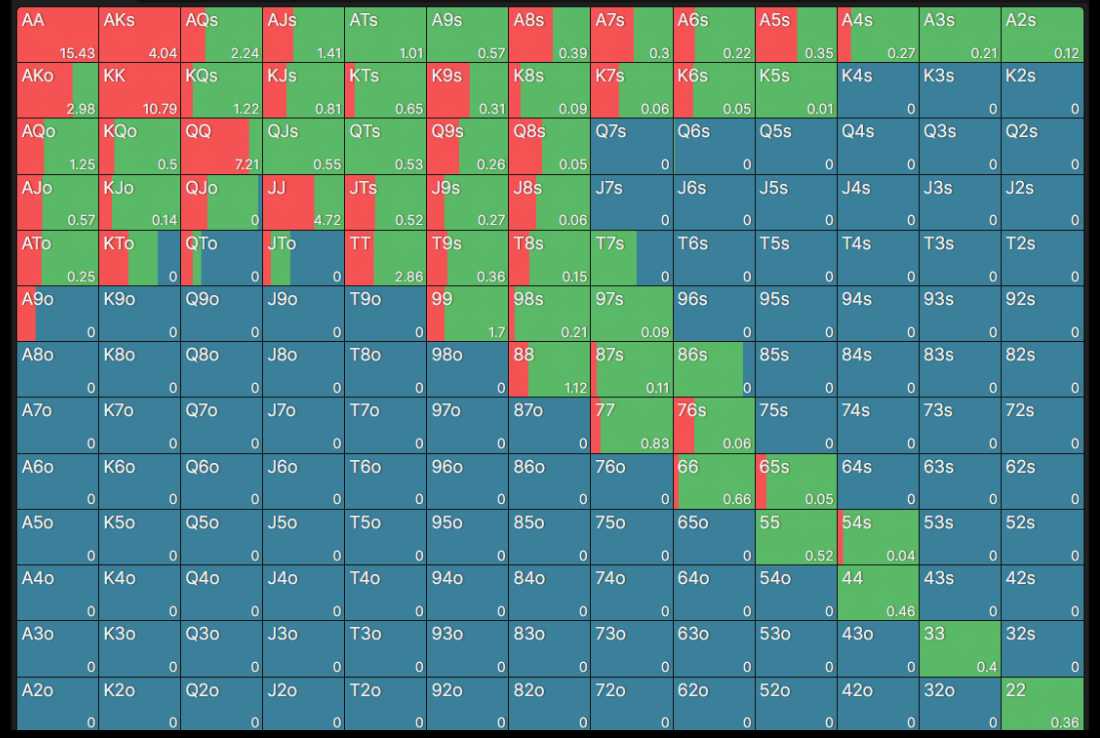
(Above: Standard Button Re-raise (red), Call (green), and Fold (blue) ranges vs. middle position opener).
This chart has you calling around 17% of hands and re-raising around 7% of hands. Note that K9s you are re-raising and calling, while K8s is mostly a call.
A helpful shortcut
But that is the “typical button” response that assumes the middle position player is making a typical opening bet. But what about our player who opened A5o, and we suspect opens wide? How do we respond? One “shortcut” I use is to find the first position where the hand the loose middle position player is playing (in our example A5o) starts to become a part of an appropriate first-in opening range.
Since A5o is a hand that first starts to appear as an appropriate “GTO opening hand” is in the cutoff position (see seat position explanations from our friends at LearnWPT), we can look at how the button reacts to the cutoff’s opening range as a model for how we might adjust. It’s not perfect because the middle position player may not be opening the entire cutoff range, but it will give us a good idea of what sorts of hands we should be expanding our range to include:
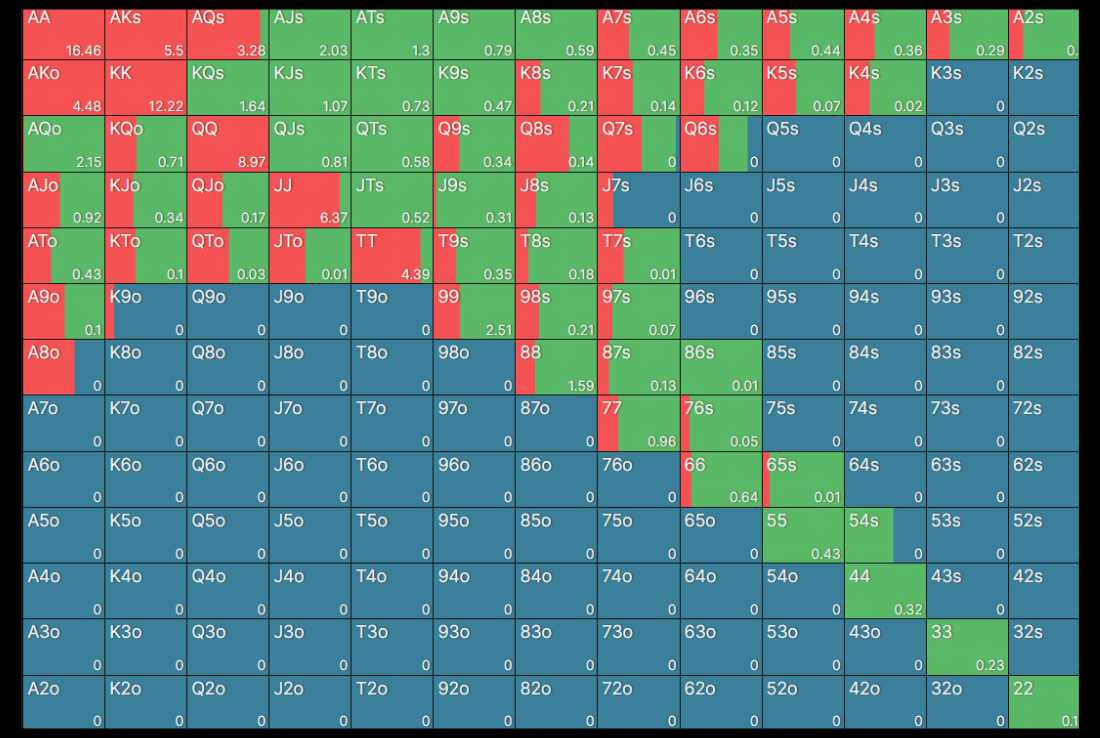
(Above: Where would A5o be a typical GTO opening hand? The answer: In the Cutoff. We adjust accordingly.)
As you can see above, against the wider opening range, the button is adjusting by expanding both the amount of hands it calls and 3-bets, now calling 18% of hands (as opposed to 17%) and 3-betting over 10% of hands (as opposed to 7%). It has mainly expanded by 3-betting a lot more of the lower Axs/Kxs/Qxs hands, although it has also started 3-betting some of the Axo more as well.
So how do we exploit?
Now, all of this is a great starting point for theoretically correct play. Since we’re talking about exploitative play, though, there are other things we’re going to want to consider.
The main other consideration is who is yet to act behind us in the blinds.
If we have weaker players who don’t 3-bet often, we would want to skew our adjustment to calling more frequently and utilizing our positional advantage postflop. This doesn’t mean abandoning 3-betting altogether. We should still 3-bet frequently, but many of the hands we might usually mix could become calls.

Conversely, if we have IveyAI and NegreanuGPT yet to act behind us in the blinds, we would want to 3-bet a lot more than call!
This discourages them from squeezing us aggressively. After all, they are going to be paying attention to the showdown as well. If they know there is a wide opener and a caller, they will astutely recognize this is an excellent squeeze spot and will be re-exploiting our exploit of calling wider by 3-betting wider and punishing us!
So, if our opponent is opening too wide in middle position, when it is folded to us after they open, we’re going to want to both call and 3-bet more frequently.
We will expand our range out to the right to include more suited hands and pay attention to the skill and tendencies of the players yet to act behind us and 3-bet more often when good, aggressive players are yet to act and call more often when weaker, more passive players are yet to act.
What about when it’s not folded to us?
Well, if someone is opening too wide and other players call, this is a perfect spot to channel our own IveyAI/NegreanuGPT and start to squeeze more liberally! When someone opens too many hands and players call loosely behind them, it creates a perfect squeeze opportunity. If there are good, aggressive players behind the loose opener who will appropriately widen their 3-betting range, we can even start to cold 4-bet bluff more to re-exploit those players!
So, as you can see, the presence of one player who is opening a bit too loose can significantly alter the preflop dynamics of the entire table. You could just stick to the standard GTO preflop charts, and you would make money off those, but you can make so much more by making adjustments to exploit the mistakes they’re making. Sometimes, you can even re-exploit good players through the bad players by squeezing and cold 4-betting a few more hands as well!
We haven’t talked a lot about post-flop up to this point, but I do want to make sure to point out that if you are calling wider to exploit the fact that your opponent has hands like A5o that don’t realize their equity well post-flop, you MUST be floating and raising post-flop to put them in difficult positions. If you call preflop with K5s and then fold every time you miss, you aren’t really exploiting them; you’re just playing more hands.
Final Thought:
If you read this article carefully, I hope you see how important it is to PAY ATTENTION to what players are doing at the table. I can’t tell you how many people are on their phones and barely pay attention to anything unless they are in a hand. These “distracted players” are often playing with less information than you. Do they know that the older player in seat four is actually playing a LAG game? Did they notice that the player in seat six always continuation bets 50% pot then checks the turn if called?
Bottom line: You can exploit better and more often if you pay attention. More on this in future articles!
Remember, in the world of poker, exploiting your opponents is not just okay; it’s your ace in the hole.
Until the next deal,
Eric “Rizen” Lynch
To see Rizen PXF videos, go to the PXF Training Center. Eric is an instructor at LearnWPT where he answers questions in their Ask a Pro service, runs live workshops, and hosts live seminars!
To be alerted to future editions to this series, sign up for the free PXF Newletter!



